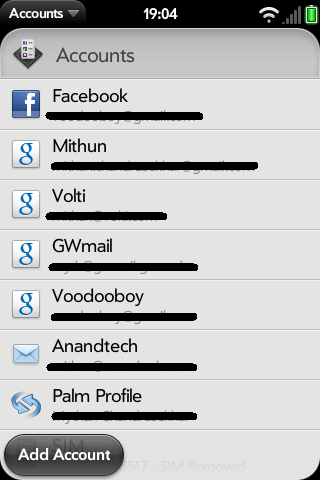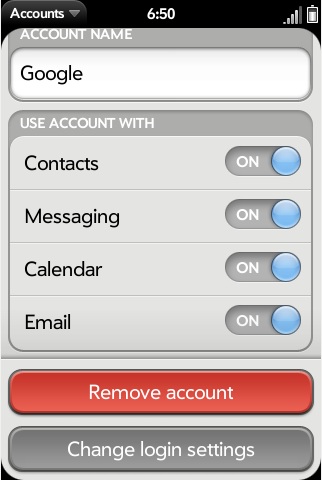webOS 2.0 Overview
by Mithun Chandrasekhar on February 3, 2011 6:05 PM ESTSynergy Revisited
The next update that webOS brings is to the contact system, what HP calls “Synergy”. The contact management system in webOS is beautiful in its concept; you have a central repository of all your contacts and each contact entry in itself acts as a collection of all information, aggregated from different sources, for that one person. So selecting Anand in my contact book would display his mobile, work, and home numbers; his AIM, Google, Yahoo, and Exchange addresses; and links to his Twitter, Facebook and Linkedin profiles (with profile pictures automatically applied as the caller ID). All of this happens without you having to do much more than enter your username/password for each of the social network accounts.



Account management is now more straightforward, but not perfect
As mentioned earlier, while a great idea, the nightmare starts when you now have hundreds of so-called contacts added to your phone, with no way or form of selecting whom to add and whom to ignore. And to add to the pain, webOS by default is not totally accurate in linking, e.g. “Anand” to his Facebook account. So you will have to go in and manually link accounts if you want a "clean" contact book.
With webOS 2.0, HP has partially addressed this issue. While webOS will still try to go ahead and add every Tom, Dick, and Harry to your contact list, you have a modicum of control over what gets synced from each account. With “Accounts”, you now have a single location from where you can add new accounts and choose if you want calendars synced from Google, contacts from Facebook added to your contact list, and/or AIM contacts added to your messaging list. I still feel it needs to provide control, one granularity-level lower, where I can choose which particular Facebook contact I want added to my list. But this all or nothing approach is certainly a marked improvement over not being given an option at all!










46 Comments
View All Comments
Noriaki - Thursday, February 3, 2011 - link
It's nice to have the flexibility of Flash I suppose, but I have little use for it in practice and I usually don't have it installed on my Nexus One. I mostly find it to be a waste of battery.On the nexus one it's a market place app I can install/remove as I like. Is there some way to control/disable Flash support in webOS2 ?
mythun.chandra - Thursday, February 3, 2011 - link
You can enable/disable Flash support in the browser. Also, even if Flash support is enabled, you can toggle whether or not to load Flash content automatically on a page.Noriaki - Thursday, February 3, 2011 - link
Oh toggle to load automatically, I like that!Thanks for the info. I'm pretty interested to see what comes of webOS2.
tekeffect - Thursday, February 3, 2011 - link
I got the pre the day it came out. I liked the OS then but the build quality of that phone was shit. I will never understand how they put that much effort into making a OS and put it on the shittiest plastic/hardware they could find. I'm with Android now with no intention of leaving. I wonder how many people would be willing to go to Web OS after so much time.JHBoricua - Thursday, February 3, 2011 - link
I would, in an instant. But, only as long as the applications are there. That's the only reason I have an Optimus LG now, I got tired of HP dragging their behind and the lack of usable applications on the Pre. The application ecosystem on Webos is pathetic at this time. I couldn't care if coming February 9 HP shows some awesome hardware, if they won't have the apps behind the platform it will be the Pre all over again.I like WebOS. IMHO it beats Android and IOS hands down in terms of usability and the user interface experience is absolutely great, but what is the point if the apps are not there?
DigitalFreak - Thursday, February 3, 2011 - link
Exactly. It's a catch 22 really. Without the apps, people won't buy the phone. Without people buying the phone, developers won't create apps.While WebOS 2.0 may be technically better than Android, iOS, etc., having only one or two phones just isn't going to cut it.
retrospooty - Sunday, February 6, 2011 - link
"I will never understand how they put that much effort into making a OS and put it on the shittiest plastic/hardware they could find"I worked for Palm for 5 years from 02 to 07. They are never able to fire on all pistons at the same time to get anything meaningful done... Alot of good people there, but the management on the hardware/engineering side is useless.
My favorite quote from a Palm employee? "I have never seen so many smart people that truly care and are trying hard, go into a meeting together and come up with such stupid solutions"
firechiefsta - Monday, February 7, 2011 - link
That's the most perfect comment I have ever read about Palm. You nailed it right on, 100%. Great work.I've loved palm since the Vx days, but these last few years have been painful, to say the least.
Sad.
DigitalFreak - Thursday, February 3, 2011 - link
"Build quality aside, the Pre/Pre Plus had the innards to, at the very least, keep up with the competition of its time and the OMAP 3630 in the Pre 2 is the very same found in the capable and well received Droid X."The Droid X will be a year old soon (if it's not already). HP should be releasing a Pre 2 with next gen hardware if they really want to capture any meaningful amount of market share. Being an also ran isn't going to work.
mythun.chandra - Thursday, February 3, 2011 - link
I get that the 3630 isn't exactly the "in" thing...quite far from it. But I honestly feel that the the pace at which mobile CPU's are jumping forward every couple of months in terms of performance, soon we will be reaching a plateau in terms of how much CPU power we really need in a 3.5-4" device. Look at the desktop/notebook sector...apart from the Atom's, when was the last time you really felt the CPU was slowing you down?IMHO, the hardware needs to complement and be able to support the software it's driving. Now whether this means using a slow, low-power CPU with a software stack that almost entirely depends on the GPU (a la Nokia N8), or have it balanced like in case of the Pre 2 and webOS 2.0. At the end of it, it is the experience of using the device that really counts, not whether the CPU underneath is running at 1 or 1.5Ghz.
That being said, the upcoming HP/Palm tablets should also whet your appetite fo raw CPU power :)